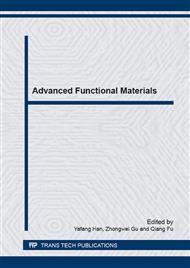[1]
E. Fattal, P. Couvreur, C. Dubernet, Smart, delivery of antisense oligonucleotides by anionic pH-sensitive liposomes, Adv Drug Deliver Rev. 56 (2004) 931-946.
DOI: 10.1016/j.addr.2003.10.037
Google Scholar
[2]
A. V. Kabanov, P. Lemieux; S. Vinogradov, V. Alakhov, Pluronic® block copolymers: novel functional molecules for gene therapy, Adv Drug Deliver Rev. 54 (2002) 223-233.
DOI: 10.1016/s0169-409x(02)00018-2
Google Scholar
[3]
Rapoport. N, Physical stimuli-responsive polymeric micelles for anti-cancer drug delivery, Prog. Polym. Sci. 32 (2007) 962-990.
DOI: 10.1016/j.progpolymsci.2007.05.009
Google Scholar
[4]
J. F. Gohy, Block copolymer Micelles, Adv. Polym. Sci. 190 (2005) 65-136.
Google Scholar
[5]
C. A. Fustin, V. Abetz, J. F. Gohy, Triblock terpolymer micelles: A personal outlook, Eur. Phys. J. E. 16 (2005) 291-302.
DOI: 10.1140/epje/i2004-10086-0
Google Scholar
[6]
G. Riess, Micellization of block copolymers, Prog. Polym. Sci. 28 (2003) 1107-1170.
Google Scholar
[7]
S. Y. Liu, S. P. Armes, Polymeric surfactants for the new millennium: A pH-responsive, zwitterionic, schizophrenic diblock copolymer, Angew. Chem. Int. Ed. 41 (2002) 1413-1416.
DOI: 10.1002/1521-3773(20020415)41:8<1413::aid-anie1413>3.0.co;2-k
Google Scholar
[8]
M. Arotcarena, B. Heise, S. Ishaya, A. Laschewsky, Switching the inside and the outside of aggregates of water-soluble block copolymers with double thermoresponsivity, J. Am. Chem. Soc. 124 (2002) 3787-3793.
DOI: 10.1021/ja012167d
Google Scholar
[9]
W. Q. Zhang, L. Q. Shi, R. J. Ma, Y. L. An, Y. L. Xu, K. Wu, Micellization of thermo- and pH-responsive triblock copolymer of poly(ethylene {TTP}8201 glycol)-b-poly(4-vinylpyridine)-b-poly (N-isopropylacrylamide), Macromolecules. 38 (2005).
DOI: 10.1021/ma050998o
Google Scholar
[10]
W. Z. Yuan, J. C. Zhang, J. R. Wei, C. Zhang, J. Ren, Synthesis and self-assembly of pH-responsive amphiphilic dendritic star-block terpolymer by the combination of ROP, ATRP and click chemistry, Eur. Polym. J. 47 (2011) 949-958.
DOI: 10.1016/j.eurpolymj.2011.01.002
Google Scholar
[11]
R. Narain, D. Jhurry, G. Wulff, Synthesis and characterization of polymers containing linear sugar moieties as side groups, Eur. Polym. J. 38 (2002) 273-280.
DOI: 10.1016/s0014-3057(01)00172-0
Google Scholar
[12]
L. E. Strong, L. L. Kiessling, A general synthetic route to defined, biologically active multivalent arrays, J. Am. Chem. Soc. 121 (1999) 6193-6196.
DOI: 10.1021/ja990223t
Google Scholar
[13]
K. Kobayashi, A. Tshuchida, A new type of artificial glycoconjugate polymer: {TTP}8201 a convenient synthesis and iIts interaction with lectins, Macromolecules. 30 (1997) 2016-(2020).
DOI: 10.1021/ma961681e
Google Scholar
[14]
A. Matsumoto, S. Ikeda, A. Harada and K. Kataoka, Glucose-Responsive polymer bearing a novel phenylborate derivative as a glucose-sensing moiety operating at physiological pH conditions, Biomacromolecules. 4 (2003) 1410-1416.
DOI: 10.1021/bm034139o
Google Scholar
[15]
Q. Q. Guo, Z.M. Wu, X.G. Zhang, L. Sun and C.X. Li, Phenylboronate-diol crosslinked glycopolymeric nanocarriers for insulin delivery at physiological pH, Soft Matter. 10 (2014) 911-920.
DOI: 10.1039/c3sm52485j
Google Scholar
[16]
L. Sun, X. G. Zhang, C. Zheng, Z. M. Wu and C. X. Li, A pH gated, glucose-sensitive nanoparticle based on worm-like mesoporous silica for controlled insulin release, J. Phys. Chem. B. 117 (2013) 3852-3860.
DOI: 10.1021/jp400442x
Google Scholar
[17]
C. H. Li, Z. S. Ge, J Fang, S.Y. Liu, Synthesis and self-Assembly of coil−rod double hydrophilic diblock copolymer with dually responsive asymmetric centipede-shaped polymer brush as the rod segment, Macromolecules. 42 (2009) 2916-2924.
DOI: 10.1021/ma900165z
Google Scholar
[18]
X. Z. Jiang, S. Z. Luo, S. P. Armes, W. F. Shi, S. Y. Liu, UV Irradiation-Induced shell cross-linked micelles with pH-responsive cores using ABC triblock copolymers, Macromolecules. 39 (2006) 5987-5994.
DOI: 10.1021/ma061386m
Google Scholar
[19]
R. Narain, S. P. Armes, Synthesis and aqueous solution properties of novel sugar methacrylate-based homopolymers and block copolymers, Biomacromolecules. 4 (2003) 1746-1758.
DOI: 10.1021/bm034166e
Google Scholar
[20]
A. Sahoo, M. Jassal, A. K. Agrawal, Influence of the copolymer architecture and composition on the response and mechanical properties of pH-sensitive fibers, J. of Appl. Polym. Sci. 105 (2007) 3171-3182.
DOI: 10.1002/app.26223
Google Scholar
[21]
Z. Deng; M. Ahmed, R. J. Narain, Novel well-defined glycopolymers synthesized via the reversible addition fragmentation chain transfer process in aqueous media, Polym. Sci: Part A: Polym. Chem. 47 (2009) 614-627.
DOI: 10.1002/pola.23187
Google Scholar
[22]
R. Narain, S. P. Armes, Synthesis of low polydispersity, controlled-structure sugar methacrylate polymers under mild conditions without protecting group chemistry, Chem. Commun. 23 (2002) 2776-2777.
DOI: 10.1039/b208654a
Google Scholar
[23]
R. Narain, S. P. Armes, Direct synthesis and aqueous solution properties of well-defined cyclic sugar methacrylate polymers, Macromolecules. 36 (2003) 4675-4678.
DOI: 10.1021/ma034321h
Google Scholar
[24]
Q. Yang, Zh. K. Xu, Zh. W. Dai, J. L. Wang, M. Ulbricht, Surface modification of polypropylene microporous membranes with a novel glycopolymer, Chem. Mater. 17 (2005) 3050-3058.
DOI: 10.1021/cm048012x
Google Scholar
[25]
X. Z. Jiang, G. Y. Zhang, R. Narain, S. Y. Liu, Fabrication of two types of shell-cross-linked micelles with inverted, structures in aqueous solution from schizophrenic water-soluble ABC triblock copolymer via click chemistry, Langmuir. 25 (2009).
DOI: 10.1021/la803616d
Google Scholar
[26]
Z. Y. Zhu, J. Xu, Y. M. Zhou, X. Z. Jiang, S. P. Armes, S. Y. Liu, Effect of salt on the micellization kinetics of pH-responsive ABC triblock copolymers, Macromolecules, 40 (2007) 6393-6400.
DOI: 10.1021/ma070978h
Google Scholar
[27]
Z. C. Deng, S. Q. Li, X. Z. Jiang, R. Narain, Well-Defined galactose-containing multi-functional copolymers and glyconanoparticles for biomolecular recognition processes, Macromolecules. 42 (2009) 6393-6405.
DOI: 10.1021/ma9010457
Google Scholar
[28]
F. Li, D. F. Pei, T. F. Shi, G. Zhang, Synthesis and characterization of novel multi-temperature responsive glycopolymers, Chem. J. of Chinese U. 32 (2011) 2243-2245.
Google Scholar
[29]
F. Li, D. F. Pei, T. F. Shi, G. Zhang, Synthesis of new pH-responsive glycopolymers by atom transfer radical polymerization, Chem. J. of Chinese U. 32 (2011) 1667-1669.
Google Scholar


